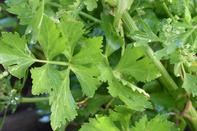
Crop Rotation
Rotate with tomatoes, potatoes, legumes or broccoli.Yield - tonnes per hectare
Conservative: 15 tonnes Average: 25 tonnes Good: 40+ tonnesHarvesting
Celery harvesting is done from 3 to 4 months after planting. Harvesting is done by hand lifting the plant and using a sharp knife to cut the stalks below the ball where the stalks are joined to separate the plant from the roots.
Commercial celery harvesting is done with special harvesting machines. This can save substantially on labour costs. It is important to harvest quickly and on time because celery that is left to mature for too long becomes fibrous and bitter.
To prevent wilting after harvest, celery should immediately be removed from the field to a cool location for washing, processing and packing.
Storage
Fresh celery is still best cut, processed, packed, marketed and sold as quickly as possible. The cool chain temperature maintained should be between 2°C and 4°C and celery is best stored at between 1°C and 2°C and at 90% to 95% relative humidity. Celery can be stored for three to four weeks.Pests
Nematodes, red spider, Plusia Looper, aphids, army worms, cutworms and leaf miners.Diseases
Heart rot, early and late blight, leaf spot. It is best to consult your local extension officer or chemical advisor for a complete crop protection programme for your specific area and conditions.
Monitor your crops daily to make sure no pest or disease is allowed to get out of control and control actions can be taken in time so that no harm can come to your celery crop.
By Louise Brodie